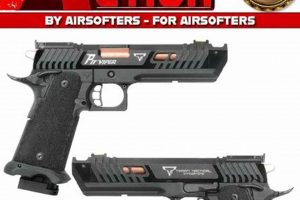Gameplay regulations for airsoft are fundamental to ensuring a safe and enjoyable experience for all participants. These guidelines encompass aspects such as acceptable projectile velocity limits, required protective gear, designated safe zones, and engagement protocols. For example, a specific guideline might stipulate that all players must wear full-seal eye protection at all times while on the playing field.
Adherence to established gaming parameters promotes player well-being by minimizing the risk of injury. The consistent application of these protocols fosters a fair and respectful environment, enhancing the overall quality of play. Historically, the development of these procedures reflects a continuous effort to balance realism with safety considerations within the sport.
The following sections will elaborate on specific categories of these standardized guidelines, providing a detailed examination of topics such as velocity restrictions, safety equipment requirements, and acceptable conduct on the field.
Guidance on Airsoft Gameplay Protocols
The following points offer practical guidance on understanding and implementing airsoft operational guidelines. These suggestions are intended to promote safety, fairness, and an enhanced overall experience.
Tip 1: Understand Velocity Limits: Adhere strictly to the stipulated projectile velocity limitations established by the venue or organizing body. Exceeding these limits poses a significant safety risk and may result in disqualification.
Tip 2: Prioritize Protective Gear: Ensure the consistent and correct usage of approved protective equipment. Full-seal eye protection, face masks, and appropriate clothing are essential to mitigating potential injuries.
Tip 3: Respect Safe Zone Protocols: Safe zones are designated areas where protective gear may be temporarily removed. Weapons must be rendered safe within these areas, typically by removing magazines and engaging the safety mechanism.
Tip 4: Observe Engagement Distances: Be cognizant of minimum engagement distances. Firing weapons at opponents within these minimum ranges may be prohibited or require reduced power settings to prevent harm.
Tip 5: Implement the “Bang-Bang” Rule Responsibly: If utilized, the “bang-bang” rule, which allows a player to eliminate an opponent at very close range, should be executed with clear verbal communication and mutual consent.
Tip 6: Medically Administering Aid: Understand that during gameplay, if a player is injured during game, always pause the game and medically administer aid.
Tip 7: Know Local Regulations: Familiarize yourself with any specific location gaming parameters that may differ from standard conventions. These may include field-specific mandates regarding acceptable weapon types or prohibited actions.
Consistent application of these suggestions will minimize risks, promote fairness, and contribute to a more enjoyable and rewarding airsoft experience for all participants.
The subsequent sections will explore specific aspects of on-field conduct and dispute resolution in greater detail.
1. Velocity limits
The practical application of velocity constraints often involves chronographs, devices used to measure the projectile’s speed. Prior to gameplay, devices are typically tested using a chronograph to ensure they comply with the field’s specific velocity restrictions. Devices exceeding the limit may be deemed unusable until modifications are made to reduce the projectile’s speed. Different field types (e.g., indoor vs. outdoor) may employ differing velocity thresholds due to variations in engagement distances and playing environments. For example, indoor facilities typically enforce lower limits to account for the more confined spaces and closer proximity between players.
In summary, velocity limits are not merely arbitrary numbers but rather fundamental safeguards integral to maintaining a safe playing environment. Overlooking or circumventing these measures undermines the integrity of the sport and places participants at unwarranted risk. The consistent and conscientious application of velocity limitations is essential for fostering a responsible and enjoyable airsoft experience. Challenges may arise in ensuring consistent enforcement across diverse gaming environments, but diligent oversight remains crucial. Understanding their significance strengthens commitment to ethical participation.
2. Eye protection mandatory
- Full-Seal DesignEye protection devices must completely seal around the ocular region, preventing projectiles from entering from any angle. Goggles, rather than simple glasses, are commonly required. Examples include ANSI Z87.1 rated goggles, which have undergone impact resistance testing. Failure to use a full-seal design renders the protective device ineffective and creates an unacceptable safety hazard.
- Impact Resistance RatingsProtective eyewear must meet or exceed specified impact resistance ratings. These ratings, such as ANSI Z87.1 or ASTM F1776, indicate the device’s ability to withstand projectile impacts at designated velocities. The selection of appropriate eyewear necessitates understanding these ratings and ensuring compatibility with the projectile velocities permitted on the field.
- Material CompositionThe materials used in the construction of protective eyewear contribute significantly to its durability and effectiveness. Polycarbonate lenses, known for their high impact resistance, are frequently employed. Frames must also be constructed from durable materials capable of withstanding repeated impacts without fracturing. Compromised material integrity can lead to catastrophic failure upon impact.
- Field-Specific RegulationsWhile general standards exist, individual fields or organizing bodies may impose stricter requirements for eye protection. These stipulations may dictate specific brands, models, or rating certifications. Adherence to these location gaming parameters is essential, as they reflect an effort to mitigate risk based on the unique characteristics of the playing environment.
The consistent and uncompromising enforcement of eye protection parameters underscores the paramount importance of player safety. Deviation from these standards constitutes a severe breach, potentially resulting in immediate expulsion. Integration of robust enforcement mechanisms, coupled with comprehensive player education, strengthens the integrity of the established gaming standards.
3. Safe zone protocol
Understanding and implementing safe zone rules carries practical significance for several reasons. Firstly, consistent application promotes a culture of responsible weapon handling. Secondly, it allows players to temporarily remove essential protective gear without fear of accidental injury. Thirdly, clearly defined procedures facilitate organized breaks and equipment maintenance. A common example of safe zone protocol includes the mandatory removal of magazines from airsoft devices upon entry, coupled with the engagement of the safety mechanism. Some fields further stipulate the use of barrel socks or plugs to visually confirm the weapon’s deactivated status.
Concluding, the safe zone protocol is intricately linked to the overall effectiveness of airsoft gaming operational guidelines. Challenges may arise in maintaining consistent compliance, particularly in large events with numerous participants. Education, clear signage, and active enforcement are key to overcoming these challenges. The stringent application of these protocols reflects a commitment to prioritizing player safety and promoting a positive gaming environment. The interrelationship between these measures demonstrates the comprehensive nature of established gameplay parameters.
4. Minimum engagement distance
Practical application varies across different venues and game types. Indoor arenas, with their confined spaces, often necessitate shorter minimum engagement distances compared to sprawling outdoor fields. Some locales may implement a “bang-bang” rule within these minimum ranges, permitting a verbal declaration of “bang” to simulate a close-range elimination rather than firing a projectile. This implementation, however, requires strict adherence to communication protocols and mutual agreement to avoid misunderstandings or disputes. Variations in engagement distances and the existence of alternative close-quarters engagement procedures underscore the necessity for participants to familiarize themselves with the location parameters prior to gameplay. The implementation is designed to prevent the effect of a possible injury.
In conclusion, minimum engagement distance rules are not arbitrary restrictions, but rather reasoned safety protocols integrated within the larger framework of established airsoft gaming standards. Challenges may emerge in consistently enforcing these distances during fast-paced gameplay; however, clear communication, vigilant observation, and a collective commitment to responsible conduct are key to successful implementation. These protocols reinforce responsible behavior and safety and promote a fair and injury-free experience.
5. Bang-bang parameters
The practical application of bang-bang parameters is often dependent on the field’s specific rules and the preferences of the participants. Some fields mandate its use within a defined minimum engagement distance, while others offer it as an optional alternative. The implementation commonly involves a clear verbal declaration, followed by a brief pause to allow the opposing player to acknowledge the elimination. The parameters may also specify limitations, such as requiring the “bang-bang” to be delivered with a weapon aimed at the target, or prohibiting its use against players who are already engaged with another opponent. Furthermore, some gaming environments require the eliminated player to visibly indicate their defeat, often through raising their weapon or donning a brightly colored cloth.
In conclusion, bang-bang parameters represent a nuanced aspect within the broader framework of responsible airsoft standards. While designed to address specific close-quarters safety concerns, their effectiveness hinges on clear articulation, consistent enforcement, and a shared understanding among participants. The successful integration of these parameters contributes to a more equitable and secure gaming environment, demonstrating the adaptive nature of these gaming parameters in response to the diverse challenges presented by varying playing environments. The overall goal is to minimize the potential for injury while maintaining the core tenets of the sport.
6. Field boundaries
- Defined Playing AreaEstablished field boundaries delineate the exact area participants are authorized to occupy during gameplay. These areas are often marked using physical barriers such as tape, netting, or natural features. The consistent application of these boundaries ensures that all participants are operating within a pre-determined and monitored space, reducing the risk of unintended interactions with external elements.
- Prevention of TrespassingClearly defined field boundaries serve to discourage players from straying into adjacent areas that may be unsafe or off-limits. This prevention is particularly important in outdoor environments where the playing field may border private property, public spaces, or hazardous terrain. Well-marked boundaries minimize the potential for legal issues and promote responsible land usage.
- Fair GameplayAdherence to established boundaries fosters fair gameplay by preventing players from gaining an unfair advantage through flanking maneuvers outside the designated area. Limiting the playing field ensures that all participants operate within the same spatial constraints, promoting strategic engagement within a balanced environment.
- Safety PerimeterField boundaries contribute to the creation of a safety perimeter between active gameplay and non-participating areas. This separation minimizes the risk of accidental injury to spectators or bystanders who may be unaware of the ongoing activity. A clearly defined boundary acts as a visual cue, alerting individuals to the potential hazards associated with entering the playing area.
Ultimately, field boundaries are not merely lines on a map, but rather essential elements in the implementation of the established framework. Their consistent enforcement underpins the integrity and safety of the gaming environment, ensuring that gameplay remains controlled, fair, and contained within designated limits. The careful consideration and maintenance of these boundaries reflects a commitment to responsible land usage and the well-being of all involved.
7. Fair play
- Honest Hit-TakingThe acknowledgment of projectile impacts constitutes a fundamental aspect of fair play. A participant registers being hit, even when unwitnessed, demonstrates integrity and upholds the spirit of the activity. Failure to accurately acknowledge impacts undermines the fairness of the gaming scenario and erodes trust among participants.
- Respectful InteractionsTreating fellow participants with respect, regardless of skill level or differing perspectives, is essential to fostering a positive environment. Refraining from unsportsmanlike conduct, such as excessive aggression or derogatory language, promotes a climate of mutual consideration and enhances the overall experience. This respect extends to acknowledging opposing players’ strategic maneuvers and tactical successes.
- Adherence to Spirit of the DirectivesFair play entails adhering not only to the letter of the directives but also to their underlying intent. Seeking to exploit loopholes or circumvent the intended purpose of any parameter undermines the ethical framework. A commitment to the underlying principles ensures that gameplay remains consistent with the established standards, even in ambiguous situations.
- Constructive Dispute ResolutionDisagreements inevitably arise during gameplay. Addressing these disputes with composure, objectivity, and a willingness to find mutually agreeable solutions exemplifies fair play. Resorting to aggression, accusations, or disruptive behavior detracts from the experience and violates the principles of sportsmanship. Seeking mediation from impartial individuals may facilitate equitable resolutions.
These interwoven facets of fair play underscore the ethical considerations within the established operational environment. Fair play strengthens mutual respect and elevates the gameplay of everyone involved. Therefore, fair play plays a vital role in responsible participation.
Frequently Asked Questions Regarding Airsoft Gameplay Regulations
This section addresses common inquiries pertaining to gameplay conduct. The intent is to clarify certain elements within standardized directives, promoting informed and compliant participation.
Question 1: What are the consequences of exceeding velocity limitations?
Exceeding velocity limitations constitutes a serious breach of established operational parameters. Consequences may range from temporary suspension from gameplay to permanent expulsion from the venue, depending on the severity of the violation and the specific field directives. Repeated or egregious infractions may result in further disciplinary action.
Question 2: Is eye protection optional for spectators within designated safe zones?
Eye protection is generally not optional within active playing environments, regardless of spectator status. While the specific directives regarding spectator eye protection may vary, adherence to posted requirements is imperative to ensure safety. Failure to comply may result in removal from the premises.
Question 3: What constitutes an acceptable method for verifying compliance with minimum engagement distances?
Compliance with minimum engagement distances is primarily reliant on player awareness and responsible conduct. Marshals or field staff may periodically monitor gameplay and issue warnings for potential violations. Utilizing visual cues, such as marking weapon barrels with colored tape to indicate minimum range, can enhance compliance. Ultimately, the responsibility for adhering to these distances rests with the individual participant.
Question 4: How are disputes regarding “hit” registration typically resolved?
Disputes pertaining to “hit” registration are often resolved through the application of the “honor system,” requiring players to accurately acknowledge impacts. In instances where uncertainty persists, requesting a marshal’s intervention or replaying the engagement may offer a suitable resolution. Repeated instances of disputed “hits” may warrant further investigation.
Question 5: Can the use of “bang-bang” be employed indiscriminately in all close-quarters situations?
The use of “bang-bang,” when authorized, is subject to specific limitations and contextual parameters. Its application typically necessitates a clear verbal declaration and, in some instances, a visual confirmation (e.g., aiming the weapon). Using “bang-bang” indiscriminately, or in violation of established guidelines, may be deemed unsportsmanlike conduct.
Question 6: Are modifications to airsoft devices that increase projectile velocity permissible?
Modifications to airsoft devices that increase projectile velocity are generally prohibited. The intent of this prohibition is to maintain compliance with pre-determined restrictions and safeguard the well-being of all participants. Altering a weapon in such a manner typically results in disqualification and potential disciplinary action.
The information presented herein is intended as a general overview of commonly encountered inquiries. Specific interpretations may differ across various venues or organizing bodies; therefore, consultation with local directives is advisable.
The following sections will address specific categories of tactical considerations in greater detail.
Airsoft Rules
This exploration has detailed the critical facets that constitute “airsoft rules,” emphasizing their function in maintaining safety, fairness, and ethical conduct. Key aspects, including velocity limits, mandatory protective gear, safe zone conduct, engagement protocols, field boundaries, and the principles of fair play, have been addressed. Consistent adherence to these established parameters is paramount to mitigating risk and cultivating a positive gaming environment.
The consistent and unwavering enforcement of established gameplay directives will safeguard participant well-being and preserve the integrity of the sport. It is incumbent upon all participants to diligently familiarize themselves with, and strictly adhere to, all governing parameters. Failure to do so carries significant potential consequences, not only for individual players but for the continued viability of airsoft as a responsibly practiced activity.







